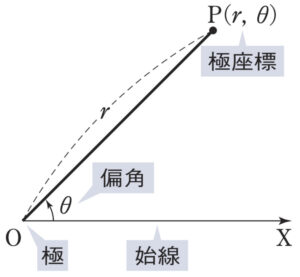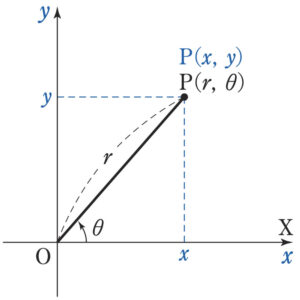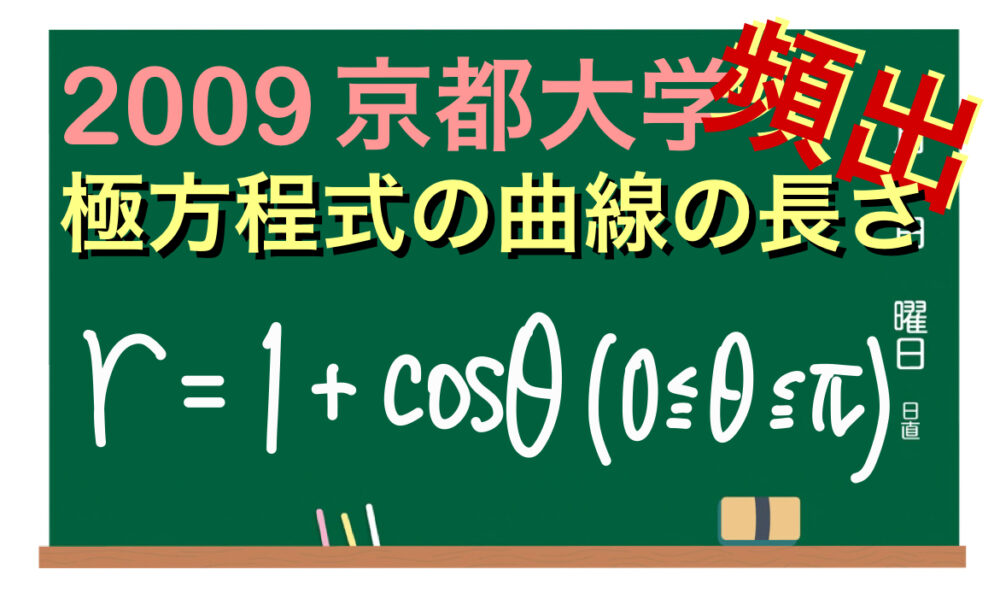【2009京都大学・甲・第6問】
極方程式 \(r=1+\cos \theta\) ( \(0≦\theta≦\pi\) ) で表される曲線の長さを求めよ.
極座標と極方程式
極座標
 平面上に点 \(O\) と半直線 \(OX\) を定めると,この平面上の任意の点 \(P\) の位置は,\(OP\) の長さ \(r\) と,\(OX\) から半直線 \(OP\) へ測った角 \(\theta\) で決まる.
平面上に点 \(O\) と半直線 \(OX\) を定めると,この平面上の任意の点 \(P\) の位置は,\(OP\) の長さ \(r\) と,\(OX\) から半直線 \(OP\) へ測った角 \(\theta\) で決まる.
このとき,\(2\) つの数の組 \((r,\theta)\) を点 \(P\) の 極座標 といい,定点 \(O\) を極,半直線 \(OX\) を始線,角 \(\theta\) を偏角という.
※ 極 \(O\) の極座標は,任意の数 \(\theta\) を用いて \(0,\theta\) と定める.また,\(\theta\) は弧度法で表した一般角.
極座標と直交座標の関係
 極座標に対して,これまで用いてきた \(x\) 座標,\(y\) 座標の組 \((x,y)\) で表した座標を直交座標という.
極座標に対して,これまで用いてきた \(x\) 座標,\(y\) 座標の組 \((x,y)\) で表した座標を直交座標という.
座標平面において,極座標を考えるとき,原点 \(O\) を極,\(x\) 軸の正の部分を始線とすると,極座標と直交座標の間には次の関係がある.
1.\(x=r\cos \theta\) , \(y=r\sin \theta\)
2.\(r=\sqrt{x^2+y^2}\)
極方程式
ある曲線が極座標 \((r, \theta)\) に関する方程式 \(r=f(\theta)\) や \(F(r, \theta)=0\) で表されるとき,この方程式を曲線の 極方程式 という.
曲線の長さ

京都大学では、2002年、2021年にも曲線の長さが出題されています!
しっかりと対策を!
媒介変数された曲線の長さ
曲線 \(x=f(t)\) , \(y=g(t)\) ( \(\alpha≦t≦\beta\) ) の長さ \(L\) は
\(L=\displaystyle\int^{\beta}_{\alpha}\sqrt{\left(\displaystyle\frac{dx}{dt}\right)^2+\left(\displaystyle\frac{dy}{dt}\right)^2} dt=\displaystyle\int^{\beta}_{\alpha}\sqrt{\left\{f^{\prime}(t)\right\}^2+\left\{g^{\prime}(t)\right\}^2} dt\)

曲線 \(y=f(x)\) の長さ
曲線 \(y=f(x)\) ( \(a≦x≦b\) ) の長さ \(L\) は
\(L=\displaystyle\int^{b}_{a}\sqrt{1+\left(\displaystyle\frac{dy}{dx}\right)^2} dx=\displaystyle\int^{b}_{a}\sqrt{1+\left\{f^{\prime}(x)\right\}^2} dx\)

解答・解説
【2009京都大学・甲・第6問】
極方程式 \(r=1+\cos \theta\) ( \(0≦\theta≦\pi\) ) で表される曲線の長さを求めよ.
\(r=1+\cos \theta\) より曲線の媒介変数表示は
\(\begin{cases}x=r\cos \theta=(1+\cos \theta)\cos \theta\\y=r\sin \theta=(1+\cos \theta)\sin \theta \end{cases}\)
であるから,
\(\displaystyle\frac{dx}{d\theta}=-\sin \theta\cos \theta+(1+\cos \theta)(-\sin \theta)\)
\(=-\sin \theta-2\sin \theta\cos \theta=-\sin \theta-\sin 2\theta\)
\(\displaystyle\frac{dy}{d\theta}=-\sin^2 \theta+(1+\cos \theta)\cos \theta\)
\(=\cos \theta+\cos^2 \theta-\sin^2 \theta=\cos \theta+\cos 2\theta\)
ゆえに,
\(\left(\displaystyle\frac{dx}{d\theta}\right)^2+\left(\displaystyle\frac{dy}{d\theta}\right)^2\)
\(=(-\sin \theta-\sin 2\theta)^2+(\cos \theta+\cos 2\theta)^2\)
\(=2+2(\sin \theta\sin 2\theta+\cos \theta\cos 2\theta)\)
\(=2+2\cos(2\theta-\theta)\)
\(=2(1+\cos \theta)\)
\(=4\cos^2 \displaystyle\frac{\theta}{2}\)
よって,求める曲線の長さ \(L\) は
\(L=\displaystyle\int^{\pi}_{0}\sqrt{\left(\displaystyle\frac{dx}{d\theta}\right)^2+\left(\displaystyle\frac{dy}{d\theta}\right)^2} d\theta\)
\(=\displaystyle\int^{\pi}_{0}\sqrt{4\cos^2 \displaystyle\frac{\theta}{2}} d\theta\)
\(0≦\theta≦\pi\) より \(\cos\displaystyle\frac{\theta}{2}≧0\) なので
\(L=\displaystyle\int^{\pi}_{0}\cos \displaystyle\frac{\theta}{2}d\theta\)
\(=\Bigl[4\sin \displaystyle\frac{\theta}{2}\Bigr]^{\pi}_{0}=4\)








コメント